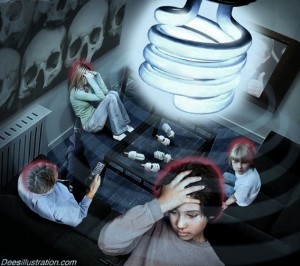Get rid of them ASAP!
Here is an article from NaturalNews:
“Compact fluorescent light bulbs are filling home and office environments with dangerous electromagnetic pollution, causing devastating health effects on some people. Neurologists are increasingly taking notice of the headaches and migraines being reported by people exposed to compact fluorescent light bulbs.
 I’ve been warning NaturalNews about CFLs for years. It’s not only the fact that they cause headaches and skin problems, it’s also the fact that they contain mercury vapor, which is highly toxic to the nervous system if inhaled. (Unless you’re a conventional dentist, of course, who absurdly believes mercury isn’t harmful to the human body.)”
I’ve been warning NaturalNews about CFLs for years. It’s not only the fact that they cause headaches and skin problems, it’s also the fact that they contain mercury vapor, which is highly toxic to the nervous system if inhaled. (Unless you’re a conventional dentist, of course, who absurdly believes mercury isn’t harmful to the human body.)”
This is why I founded EcoLEDs (www.EcoLEDs.com), which has been selling mercury-free, eco-friendly LED lights since late 2007. But LED lights are still too expensive for most consumers, and they’re nowhere near the affordability of compact fluorescent bulbs.
Meanwhile, CFLs are all the rage these days, with hotels, offices and retail stores all turning to them as light sources, unwittingly unleashing a new wave of electromagnetic pollution onto consumers.
So what should you do in your home? Don’t buy compact fluorescent light bulbs! Buy LED lights and you’ll earn back the entire cost of the lights in just a couple of years due to savings on electricity expenditures. If you can’t afford LEDs, stick with regular incandescent light bulbs until a better solution comes along. They aren’t the best thing for the environment, but neither are mercury-containing CFL light bulbs, almost none of which are properly disposed of anyway.
(NaturalNews) Are you one of the many who, in the effort to be eco-friendly and to save money, replaced your old incandescent light bulbs with environmentally-friendly compact fluorescent lamps (CFLs) energy saving light bulbs? If so, beware. A new study conducted by conducted by Peter Braun at Berlin Germany’s Alab Laboratory found these light bulbs contain poisonous carcinogens that could cause cancer. These include:
 Phenol, a mildly acidic toxic white crystalline solid, obtained from coal tar and used in chemical manufacture (http://en.wikipedia.org/wiki/Phenol).
Phenol, a mildly acidic toxic white crystalline solid, obtained from coal tar and used in chemical manufacture (http://en.wikipedia.org/wiki/Phenol).
Naphthalene, a volatile white crystalline compound, produced by the distillation of coal tar, used in mothballs and as a raw material for chemical manufacture (http://en.wikipedia.org/wiki/Naphthalene).
Styrene, an unsaturated liquid hydrocarbon, obtained as a petroleum byproduct(http://en.wikipedia.org/wiki/Styrene).
The German scientists involved caution to keep these light bulbs “as far away as possible from the human environment.” If used, they advise that you use the bulbs sparingly, in areas with good ventilation, and “definitely not in the proximity of the head,” as the bulbs generate electrical smog, impacting human health.
The new German study supports similarly disturbing findings of Abraham Haim, a professor of biology at Haifa University in Israel, who found that the light emitted by CFLs increased the likelihood of women getting breast cancer by disrupting the body’s production of the hormone melatonin.
What a dilemma for Americans. Following a 2007 bill signed into law by President George W. Bush, the US government will ban the sale of 100 watt traditional incandescent light bulbs and replace them with toxic CFLs by  January 1, 2012, followed by the 75-watt version in Jan. 2013, and the 60- and 40-watt bulbs in Jan. 2014. This will follow on the heels of the Europeans who began to phase out incandescent bulbs in 2009 and by 2016 the EU also plans to ban halogen bulbs, forcing people to use compact fluorescents.
January 1, 2012, followed by the 75-watt version in Jan. 2013, and the 60- and 40-watt bulbs in Jan. 2014. This will follow on the heels of the Europeans who began to phase out incandescent bulbs in 2009 and by 2016 the EU also plans to ban halogen bulbs, forcing people to use compact fluorescents.
This legislation pits the lawmakers against environmental groups that strongly back the new standards,” states USA Today news (http://www.usatoday.com/news/washington/2011-03-10-lightbulbs10_ST_N….), “which require manufacturers to produce bulbs that use 25% to 30% less energy than standard incandescents, starting Jan. 1.”
That CFLs are harmful is not new information. It is well known that they contain toxic mercury, a neurotoxin that can damage the brain, liver, kidneys and central nervous system. The bulbs are marketed as “safe” as long as the glass remains intact. The danger comes, reports FoxNews (http://www.foxnews.com/health/2011/03/07/danger-lurking-compact-fluor…), if the bulbs are cracked, broken or not disposed of properly causing the toxic dust to spread into the air. Just one fluorescent light bulb contains enough mercury to contaminate 6,000 gallons of water and in humans to impair motor functioning, cognitive ability and emotional stability.
Moreover, the “dirty energy” emitted by CFLs produces radiation that has been linked with migraine headaches, sleep abnormalities, fatigue, and other health defects while the flickering of fluorescent bulbs causes dizziness, headaches, weakness and illness in some sensitive people.
